The King of Fighters (KOF) is a series of fighting games by SNK that began with the release of The King of Fighters '94 in 1994. The series was developed originally for SNK's Neo Geo MVS arcade hardware. This served as the main platform for the series until 2004 when SNK retired it in favor of the Atomiswave arcade board. Two King of Fighters games were produced for the Atomiswave platform (The King of Fighters Neowave and The King of Fighters XI) before SNK decided to discontinue using it for the series. The series' most recent arcade hardware is the Taito Type X2, first used with the release of The King of Fighters XII. Ports of the arcade games and the original The King of Fighters games have been released for several video game consoles. The latest entry in the series, The King of Fighters XV, was released in February 2022.
SNK vs. Capcom, or alternately Capcom vs. SNK, is a series of crossover video games by either Capcom or SNK featuring characters that appear in games created by either company. Most of these are fighting games, and take on a similar format to Capcom's own Marvel vs. Capcom series, in which the players create teams of fighters and have them fight each other. Games in this series either contain SNK vs. Capcom or Capcom vs. SNK in their titles, with the first company named denoting the company behind the game's development.

Marvel vs. Capcom is a series of crossover fighting games developed and published by Capcom, featuring characters from their own video game franchises and comic book series published by Marvel Comics. The series originated as coin-operated arcade games, though later releases would be specifically developed for home consoles, handhelds, and personal computers.

Capcom vs. SNK 2: Mark of the Millennium 2001 is the sequel to the fighting game Capcom vs. SNK. It was originally released on NAOMI hardware in arcades, with Sega handling the American arcade release. As in the original, players select a team of fighters from various Capcom and SNK games then fight other teams, winning each battle by defeating all the opponents from the other team.
Capcom Fighting All-Stars: Code Holder is a cancelled 3D fighting game developed by Capcom for arcade and PlayStation 2. The game would have featured characters from various Capcom franchises fighting to prevent a massive bomb from exploding. The game was canceled in 2003 due to poor feedback during its testing period, though it would influence the release of Capcom Fighting Evolution the following year.
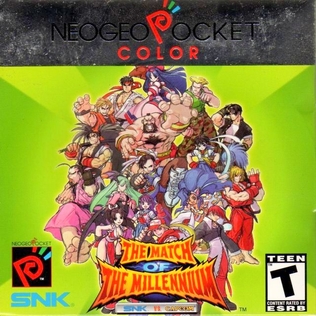
SNK vs. Capcom: The Match of the Millennium is a crossover fighting game developed and published by SNK for the Neo Geo Pocket Color in 1999.

KOF: Maximum Impact (KOFMI) is a fighting game developed by SNK subsidiary Noise Factory and published by SNK Playmore for the PlayStation 2 in 2004. An enhanced version was released for both the Xbox and PlayStation 2 under the title KOF Maximum Impact: Maniax. The PS2 version of 'Maniax' was only released in Japan, and the Xbox version was not released in Europe.

The King of Fighters XI(KOF XI) is a 2D fighting game produced by SNK Playmore. It is the eleventh installment in The King of Fighters series following The King of Fighters 2003. It was originally released as a coin-operated arcade game for the Atomiswave platform in 2005. A home version for the PlayStation 2 was released in Japan in 2006, followed by releases in the PAL region and North America in 2007. It is the second The King of Fighters game to not run on the Neo Geo following its predecessor, The King of Fighters Neowave and also the first major canonical entry to not be named after its year of release.

Garou: Mark of the Wolves is a 1999 fighting game produced by SNK, originally for the Neo Geo system and then as Fatal Fury: Mark of the Wolves for the Dreamcast. It is the eighth installment of the Fatal Fury series.
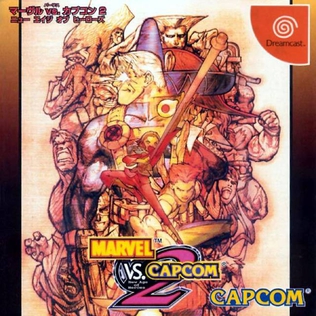
Marvel vs. Capcom 2: New Age of Heroes is a crossover fighting game developed and published by Capcom. It is the fourth installment in the Marvel vs. Capcom series, which features characters from both Capcom's video game franchises and comic book series published by Marvel Comics. Originally released in Japanese arcades in 2000, the game received ports to the Dreamcast, PlayStation 2, PlayStation 3, Xbox, Xbox 360, and iOS devices over the span of twelve years.

The King of Fighters 2002: Challenge to Ultimate Battle(KOF 2002, or KOF '02) is a fighting game developed by Eolith and published by Eolith and Playmore for the Neo Geo in 2002. It is the ninth game in The King of Fighters series and the second one to be produced by Eolith. The game was ported to the Dreamcast, PlayStation 2, and the Xbox, where in the PS2 and Xbox versions were released in North America in a two-in-one bundle with the following game in the series, The King of Fighters 2003. The Dreamcast port was released only in Japan, it was also the last game in the series to be officially released for the Japanese Dreamcast.
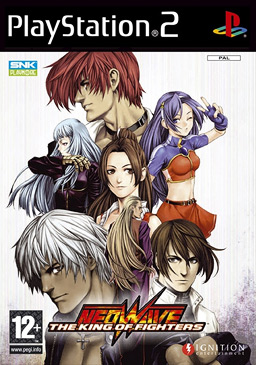
The King of Fighters Neowave(KOF Neowave, or KOF NW) is a 2D fighting game produced by SNK Playmore and released as a coin-operated arcade game for Sammy's Atomiswave hardware in 2004. It was the first game SNK Playmore produced for the Atomiswave. This is a remake of The King of Fighters 2002 with a major change of roster and stages, the game was also made on the PlayStation 2 and Xbox. The PS2 version was released only in Japan and the PAL region, the Xbox version was released both in Japan and North America. The North American version was released on April 18, 2006. In 2020, a Dreamcast homebrew adaptation of the arcade version was also made possible due to the Dreamcast sharing almost identical hardware with its Atomiswave cousin. The character artwork was done by Tomokazu Nakano. In Japan, it was the last game to be released for the Xbox.
Tatsuhiko Kanaoka, better known by his pen name Falcoon is a Japanese artist. He works for SNK. He has been involved in several iterations of The King of Fighters franchise.

Capcom vs. SNK: Millennium Fight 2000, also known as simply Capcom vs. SNK in international releases, is a 2000 head-to-head fighting game produced by Capcom originally released as a coin-operated arcade game for Sega's NAOMI hardware and later ported to the Dreamcast. It is the second game in the SNK vs. Capcom series and the first game in the series to be released for the arcade.
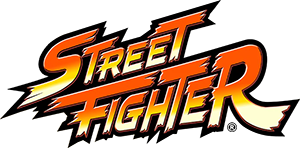
Street Fighter is a Japanese media franchise centered on a series of fighting games developed and published by Capcom. The first game in the series was released in 1987, followed by six other main series games, various spin-offs and crossovers, and numerous appearances in other media. Its best-selling 1991 release Street Fighter II established many of the conventions of the one-on-one fighting genre.

Ghosts 'n Goblins, known in Japan as Makaimura, is a run-and-gun platform video game series created by Tokuro Fujiwara and developed by Capcom. The first entry in the series was Ghosts 'n Goblins, released in arcades on July 7, 1985. The series has subsequently been ported to and released on a variety of personal computers, game consoles and mobile platforms and spawned several sequels and spin-offs.

The King of Fighters XIII(KOF XIII) is a fighting game in The King of Fighters series, developed and published by SNK Playmore originally in 2010. King of Fighters XIII was released for Japanese arcades on July 14, 2010, while ports for the Xbox 360 and PlayStation 3 were released during late 2011 in Japanese and English regions, with Atlus USA and Rising Star Games being in charge of releasing them in the United States and Europe respectively. Versions for iOS and Android followed in 2011 and 2012. A PC version was released on Steam on September 13, 2013.

Capcom Fighting Evolution is a 2004 head-to-head fighting game from Capcom. It was originally released as a coin-operated arcade game for the Namco System 246 hardware and ported to the PlayStation 2 and Xbox. The game features characters from three different incarnations of the Street Fighter series, as well as characters from the Darkstalkers series and the CPS III arcade game Red Earth, with each character employing the fighting system from the game which they represent.
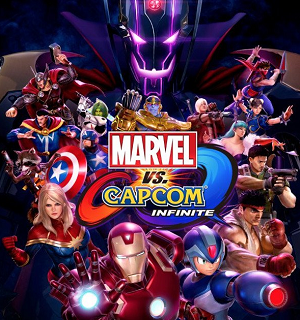
Marvel vs. Capcom: Infinite is a fighting video game developed and published by Capcom. It is the sixth main entry in the Marvel vs. Capcom series of crossover games. Like previous installments, players control characters from both the Marvel Comics and Capcom universes to compete in tag team battles. Infinite features two-on-two fights, as opposed to the three-on-three format used in its preceding titles. The series' character-assist moves have been removed; instead, the game incorporates a tag-based combo system, which allows players to instantly switch between their two characters to form continuous combos. It also introduces a new gameplay mechanic in the form of the Infinity Stones, which temporarily bestow players with unique abilities and stat boosts depending on the type of stone selected.
















